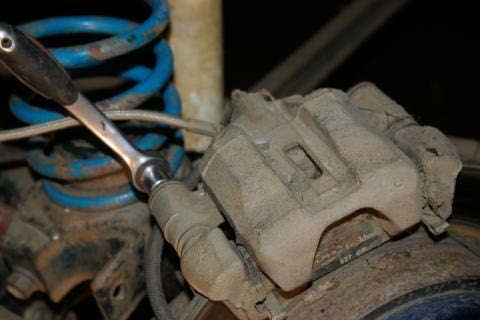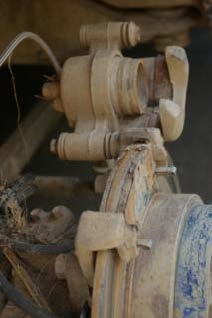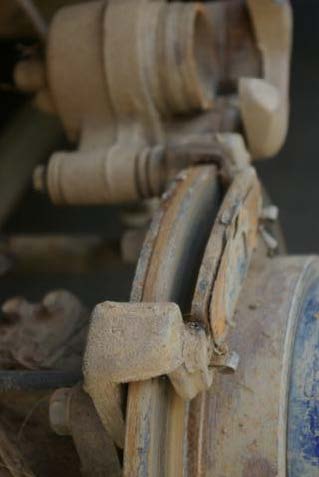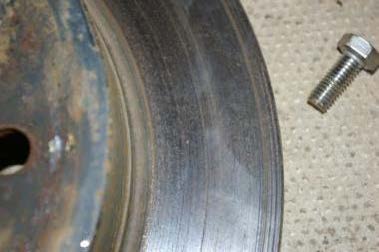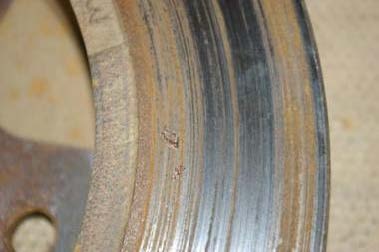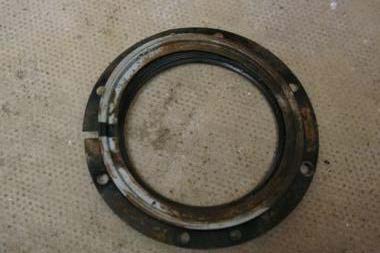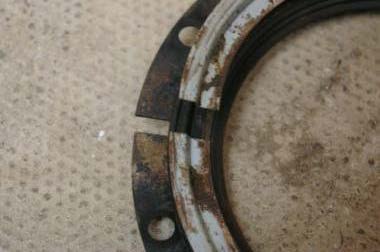Difference between revisions of "CV joint replacement"
(A brand new chapter (large table) on required and recommended parts and fluids) |
|||
| Line 16: | Line 16: | ||
== CV joint information == | == CV joint information == | ||
| + | |||
=== Identifying type === | === Identifying type === | ||
| − | Suzuki uses two different CV joints in the Jimny. One is straight forward to purchase on the parts | + | |
| + | Suzuki uses two different CV joints in the Jimny. One is straight forward to purchase on the parts aftermarket and the other is nearly impossible to source. | ||
* Type 1: 6 balls, 26 external splines and 19 internal splines. - [https://www.bigjimny.com/store/cv-joint-type-1.html BigJimny Store] NTN 75LAC CT9U) | * Type 1: 6 balls, 26 external splines and 19 internal splines. - [https://www.bigjimny.com/store/cv-joint-type-1.html BigJimny Store] NTN 75LAC CT9U) | ||
* Type 2: 8 balls, 26 external splines and 29 internal splines. - [https://www.bigjimny.com/store/cv-joint-type-2.html BigJimny Store] (possibly marked NTN EBJ82 although NTN call it an 8-Ball CV) | * Type 2: 8 balls, 26 external splines and 29 internal splines. - [https://www.bigjimny.com/store/cv-joint-type-2.html BigJimny Store] (possibly marked NTN EBJ82 although NTN call it an 8-Ball CV) | ||
| − | {{ | + | {{warning|Ensure that you obtain the correct CV joint type for your vehicle!}} |
| + | |||
{| class="wikitable" | {| class="wikitable" | ||
| Line 56: | Line 59: | ||
|} | |} | ||
| − | === | + | |
| − | Note: check the specific joint for your vehicle before ordering | + | === CV Joint compatibility === |
| + | |||
| + | |||
| + | Note: check the specific joint for your vehicle before ordering. | ||
| + | |||
{| class="wikitable" | {| class="wikitable" | ||
| Line 63: | Line 70: | ||
! Engine | ! Engine | ||
! VIN Number | ! VIN Number | ||
| − | !CV Type | + | ! CV Type |
|- | |- | ||
|Japan (JSA) | |Japan (JSA) | ||
| Line 91: | Line 98: | ||
| − | <gallery widths= | + | <gallery widths=256 heights=192> |
ntn75lac.jpg|NTN 75LAC CV Joint | ntn75lac.jpg|NTN 75LAC CV Joint | ||
ntn75lac-outer.jpg|NTN 75LAC CV Joint - 26 Outer splines | ntn75lac-outer.jpg|NTN 75LAC CV Joint - 26 Outer splines | ||
| Line 97: | Line 104: | ||
</gallery> | </gallery> | ||
<br clear=all> | <br clear=all> | ||
| + | |||
==== NTN EBJ82 Style CV Joint ==== | ==== NTN EBJ82 Style CV Joint ==== | ||
| + | |||
Note these pictures are of a 6-ball copy (the real thing is an 8 ball CV but is not available as a standalone CV, it comes with the full drive shaft) | Note these pictures are of a 6-ball copy (the real thing is an 8 ball CV but is not available as a standalone CV, it comes with the full drive shaft) | ||
| − | <gallery widths= | + | <gallery widths=256 heights=192> |
ntnEBJ82.jpg|NTN EBJ82 Style CV Joint | ntnEBJ82.jpg|NTN EBJ82 Style CV Joint | ||
ntnEBJ82-outer.jpg|NTN EBJ82 Style CV Joint - 26 Outer splines | ntnEBJ82-outer.jpg|NTN EBJ82 Style CV Joint - 26 Outer splines | ||
| Line 108: | Line 117: | ||
</gallery> | </gallery> | ||
<br clear=all> | <br clear=all> | ||
| + | |||
== Changing the CV joint == | == Changing the CV joint == | ||
| − | === | + | Before embarking onto any work, first comes the overview of the prerequisites. |
| + | |||
| + | |||
| + | === Required parts === | ||
| + | |||
| + | <font face="courier"> | ||
| + | {| class="wikitable" | ||
| + | |+Required and recommended parts and fluids (for one side / wheel) | ||
| + | !Part name | ||
| + | !Quantity | ||
| + | !Suzuki P.N. | ||
| + | !Aftermarket replacements | ||
| + | !Comments | ||
| + | |- | ||
| + | |Constant velocity joint | ||
| + | |1 piece | ||
| + | |Type 1:<br>44101-81A00 (right)<br>44102-81A00 (left)<br><br>Type 2:<br>44101-84A00 (right)<br>44102-84A00 (left) | ||
| + | |Type 1:<br>''Various''<br><br>Type 2:<br>1. [http://www.herthundbuss.com/en/new/online-catalogue.html Herth+Buss Jakoparts J2828040]<br>2. [http://www.nknjoints.com NKN N-5979-2HO] | ||
| + | |Original Suzuki CV joints are galactically expensive because they always come pre-assembled together with a halfshaft.<br>The left and right Suzuki CV joint of the same type are identical, only the halfshafts are different.<br>See the chapter about CV joint types for more info about different CV joint types. | ||
| + | |- | ||
| + | |Halfshaft oil seal | ||
| + | |1 piece | ||
| + | |09283-26016 | ||
| + | |Any seal with dimensions:<br>"26 x 38 x 9" (best fit);<br>"26 x 38 x 8" (good fit);<br>"26 x 38 x 7" (okay fit); | ||
| + | |Changing this part is not strictly needed in this procedure, especially if it is found to be in good condition after all the dismantling.<br>However, since it is so cheap compared to the CV joint, and since you will need it sooner or later anyway, it is recommended to preventively obtain one now.<br>Original Suzuki seal is recommended, because it has special "double lip" construction.<br>Aftermarket seals usually do not have double lips.<br>Also, most of them are shallower (8 mm or even 7 mm depth compared to Suzuki's 9 mm).<br>While a shallower seal is not a critical mismatch, is is always better to avoid that.<br>Reason: smaller sealing / contact area. | ||
| + | |- | ||
| + | |Steering knuckle swivel seal | ||
| + | |1 piece | ||
| + | |45120-81A04 | ||
| + | |Febest SZOS-001 | ||
| + | |Might not be needed if the current one is not worn out.<br>Its condition is easy to check just by thoroughly looking under the vehicle.<br>Check if the seal's lip is torn, cracked, jammed, kinked, etc.<br>The current P.N. is the 4th (best quality) revision by Suzuki.<br>There used to be older revisions (ending with 81A01, 81A02 and 81A03).<br>Buy an older revision only if it is on a good discount!<br>All those revisions are mutually fully compatible.<br>Buy the Febest replacement only if you can't obtain any Suzuki's original seal. | ||
| + | |- | ||
| + | |Differential oil | ||
| + | |1.1 - 1.65 litre | ||
| + | |Who cares | ||
| + | |See the wiki article:<br>[[Forecourt|'''"Forecourt"''']] | ||
| + | |Not strictly needed (if you jack up only one side of the car, no oil will leak from the axle).<br>However, it is a good idea to change it if the schedule for its replacement is due anyway. | ||
| + | |- | ||
| + | |Heavy-duty nuclear-proof grease | ||
| + | |A handful or so | ||
| + | |? | ||
| + | |[https://www.zeller-gmelin.de/downloads/ti/23980/de/TI-DE-23980.pdf Divinol Fett Top 2003 (23980)];<br> | ||
| + | |This is perhaps the most important part!<br>A super-durable ''water-and-mud-and-everything-else'' resistant grease is essential for the steering knuckle assembly and for the king pin bearings, to protect from grit, water and mud, which will '''certainly''' enter the steering knuckle (one of Jimny's main weaknesses).<br>Forum user Bosanek has had excellent experience with the stated Divinol 23980 grease.<br>This grease is truly wicked - fluorescent green, super thick, very sticky and gooey, like a slime from another galaxy.<br>After a year of hard use, the steering knuckles were opened and it was like a mass grave inside, but this Divinol grease repelled all the grit and sh*t away from the king pin bearings, still keeping them fully and cleanly greased!<br>On the other hand, this Divinol 23980 grease ''might'' not be suitable for use in a CV joint (just a presumption because it is very thick and "gooey" - somebody has yet to try it in a CV joint).<br>See the next item for a field-proven CV joint grease.<br>Others are welcome to add their own recommendations to the list! | ||
| + | |- | ||
| + | |Heavy-duty CV joint grease | ||
| + | |A handful or so | ||
| + | |? | ||
| + | |[http://www.abro.com/lg-990.html Abro LG-990] (here are [https://abro-rus.ru/catalog/smazki-/smazka-litievaya-sinyaya-sinteticheskaya-3/?sphrase_id=5609 more detailed specifications]);<br> | ||
| + | |This is also an extremely important part!<br>A heavy-duty ''water-and-mud-and-everything-else'' resistant grease is essential to keep your CV joint protected from grit, water and mud, which will '''certainly''' enter the steering knuckle (one of Jimny's main weaknesses).<br>However, a CV joint grease also has to have proper greasing viscosity and consistency (e.g. non-liquifying) properties even under heavy load, high temperatures and high velocities.<br>Forum user Bosanek has had very good experience with the stated Abro LG-990 fully synthetic lithium grease when used in a CV joint.<br> It is not nearly as tough as the wicked Divinol 23980 grease, but on the other hand, it is a "safe bet" to keep the sensitive CV joint properly greased in all operating conditions.<br>Others are welcome to add their own recommendations to the list! | ||
| + | |- | ||
| + | |A calendar with pictures of (half)naked women | ||
| + | |12 pictures / months | ||
| + | |Who cares | ||
| + | |Claudia Schiffer;<br>Ana Kournikova;<br>Monica Bellucci;<br>Salma Hayek;<br>Bridgitte Bardot; | ||
| + | |An essential part of pleasant working experience in most mechanical garages;<br>It is recommended to flip over calendar's pages / months one by one as you progress trough each step in this guide; | ||
| + | |} | ||
| + | </font> | ||
| + | |||
| + | |||
| + | === Required tools === | ||
| − | {{tools|<ul><li> Standard metric sockets and spanners</li><li>Assorted screwdrivers</li><li>Circlip pliers ( | + | |
| + | {{tools|<ul><li> Standard metric sockets and spanners</li><li>Assorted screwdrivers</li><li>Circlip pliers (external)</li><li>An E10 Torx socket for the vacuum hub head bolts</li><li>A ball joint splitter</li><li>1" imperial Socket</li><li>G-Clamp or brake piston retractor</li><li>A Big F.....g Hammer (only if you have anger management problems)</li></ul> | ||
<br> | <br> | ||
}} | }} | ||
| Line 132: | Line 202: | ||
| − | [[File:Caliper.jpg|thumb|left| | + | [[File:Caliper.jpg|thumb|left|480px|Jimny Front Caliper]] |
* First of all secure the car. | * First of all secure the car. | ||
| Line 140: | Line 210: | ||
<br clear=all> | <br clear=all> | ||
| − | [[File:Unbolt_caliper.jpg|thumb|left| | + | [[File:Unbolt_caliper.jpg|thumb|left|480px|Unbolting the caliper]] |
* Using a 12mm spanner, release the front caliper bolt (the left is the front of the car in this picture). | * Using a 12mm spanner, release the front caliper bolt (the left is the front of the car in this picture). | ||
| Line 146: | Line 216: | ||
<br clear=all> | <br clear=all> | ||
| − | [[File:Open_caliper.jpg|thumb|left| | + | [[File:Open_caliper.jpg|thumb|left|212px|Open brake caliper]] |
* The caliper then opens up using the rear bolt as a hinge. | * The caliper then opens up using the rear bolt as a hinge. | ||
<br clear=all> | <br clear=all> | ||
| − | [[File:Removing_pads.jpg|thumb|left| | + | [[File:Removing_pads.jpg|thumb|left|319px|Removing the brake pads]] |
* The pads are retained by small spring clips. | * The pads are retained by small spring clips. | ||
| Line 163: | Line 233: | ||
| − | [[File:Carrier_bolt.jpg|thumb| | + | [[File:Carrier_bolt.jpg|thumb|252px|left|Carrier bolt]] |
* The caliper is held on with two bolts at the rear (see below). | * The caliper is held on with two bolts at the rear (see below). | ||
<br clear=all> | <br clear=all> | ||
| − | [[File:Carrier_to_spring.jpg|thumb| | + | [[File:Carrier_to_spring.jpg|thumb|380px|left|Caliper tied to Spring]] |
* Release the bolts and tie the caliper to the spring to keep it out of the way. | * Release the bolts and tie the caliper to the spring to keep it out of the way. | ||
<br clear=all> | <br clear=all> | ||
| − | [[File:Disc_removal.jpg|thumb| | + | [[File:Disc_removal.jpg|thumb|375px|left|Disc removal using bolt]] |
* Now the front brake disc can be removed. | * Now the front brake disc can be removed. | ||
| Line 184: | Line 254: | ||
* New [https://www.bigjimny.com/store/brake-disc-suzuki-jimny-107mm.html disks] are available in the [https://www.bigjimny.com/store/ BigJimny Store]. | * New [https://www.bigjimny.com/store/brake-disc-suzuki-jimny-107mm.html disks] are available in the [https://www.bigjimny.com/store/ BigJimny Store]. | ||
| − | <gallery widths= | + | <gallery widths=379 heights=252> |
Disc_front.jpg | Disc_front.jpg | ||
Disk_rear.jpg | Disk_rear.jpg | ||
| Line 194: | Line 264: | ||
| − | [[File:freewheelinghub.jpg|thumb| | + | [[File:freewheelinghub.jpg|thumb|379px|left|Torx bolt on hub]] |
* Now the Freewheeling Hub needs to be removed. | * Now the Freewheeling Hub needs to be removed. | ||
| Line 200: | Line 270: | ||
<br clear=all> | <br clear=all> | ||
| − | [[File:hubcirclip.jpg|thumb| | + | [[File:hubcirclip.jpg|thumb|380px|left|Removing the circlip]] |
* With the hub removed, the driveshaft is exposed. | * With the hub removed, the driveshaft is exposed. | ||
| Line 209: | Line 279: | ||
<br clear=all> | <br clear=all> | ||
| − | [[File:vacuumpipe.jpg|thumb| | + | [[File:vacuumpipe.jpg|thumb|378px|left|removing a vacuum pipe]] |
* Gently pull the two vacuum hoses for the hub from the knuckle, making sure you note which one connects to each pipe. | * Gently pull the two vacuum hoses for the hub from the knuckle, making sure you note which one connects to each pipe. | ||
| Line 219: | Line 289: | ||
| − | [[File:swivelsealbolts.jpg|thumb| | + | [[File:swivelsealbolts.jpg|thumb|251px|left|Removing the swivel seal bolts]] |
* At the rear of the hub, release the small bolts holding the seal and retainer. | * At the rear of the hub, release the small bolts holding the seal and retainer. | ||
| Line 225: | Line 295: | ||
<br clear=all> | <br clear=all> | ||
| − | [[File:balljointsplitter.jpg|thumb| | + | [[File:balljointsplitter.jpg|thumb|379px|left|Splitting the ball joint]] |
*Undo the nuts on the steering joints. | *Undo the nuts on the steering joints. | ||
| Line 232: | Line 302: | ||
<br clear=all> | <br clear=all> | ||
| − | [[File:kingpinbolts.jpg|thumb| | + | [[File:kingpinbolts.jpg|thumb|375px|left|undoing the Kingpin bolts]] |
* Finally, release the KingPin bolts themselves. | * Finally, release the KingPin bolts themselves. | ||
| Line 248: | Line 318: | ||
<br clear=all> | <br clear=all> | ||
| − | [[File:Old CV Joint.jpg|thumb| | + | [[File:Old CV Joint.jpg|thumb|479px|left|Removing the C-Clip]] |
* The CV Joint is held on the driveshaft by a hidden C-Clip. | * The CV Joint is held on the driveshaft by a hidden C-Clip. | ||
| Line 255: | Line 325: | ||
<br clear=all> | <br clear=all> | ||
| − | [[File:New_CV_joint.jpg|thumb| | + | [[File:New_CV_joint.jpg|thumb|476px|left|New CV Joint]] |
* Now put the new C-clip onto the shaft and tap the new joint into place. | * Now put the new C-clip onto the shaft and tap the new joint into place. | ||
| Line 265: | Line 335: | ||
* This is basically the reverse process. | * This is basically the reverse process. | ||
| − | * You may wish to change the | + | * You may wish to change the king pin bearings and oil seals at this point if you wish. |
* If you are changing the large seal then now is the time to put the new one on. | * If you are changing the large seal then now is the time to put the new one on. | ||
* The confusing part is the order of the seals and rings on the swivel, the picture below is of the correct orientation, note also that the slits in the retainers go to the top. | * The confusing part is the order of the seals and rings on the swivel, the picture below is of the correct orientation, note also that the slits in the retainers go to the top. | ||
| − | <gallery widths= | + | <gallery widths=380 heights=253> |
seal1.jpg | seal1.jpg | ||
seal2.jpg | seal2.jpg | ||
| Line 276: | Line 346: | ||
<br clear=all> | <br clear=all> | ||
| − | [[File:cvjoint.jpg|thumb| | + | [[File:cvjoint.jpg|thumb|375px|left|The greased CV joint]] |
* Pack the CV with grease (but do not overpack) and re-fit the driveshaft. | * Pack the CV with grease (but do not overpack) and re-fit the driveshaft. | ||
| Line 282: | Line 352: | ||
<br clear=all> | <br clear=all> | ||
| − | [[File:sealant.jpg|thumb| | + | [[File:sealant.jpg|thumb|362px|left|Applying sealant]] |
* Grease the new KingPin bearings and insert the top one in the carrier. | * Grease the new KingPin bearings and insert the top one in the carrier. | ||
| Line 305: | Line 375: | ||
Full details of the torque settings can be found in the [[Torque#Front_Hub | reference data]] | Full details of the torque settings can be found in the [[Torque#Front_Hub | reference data]] | ||
<br clear=all> | <br clear=all> | ||
| + | |||
{{Edited}} | {{Edited}} | ||
[[Category:Howto]][[Category:Steering]] | [[Category:Howto]][[Category:Steering]] | ||
Revision as of 13:55, 23 March 2018
![]() The content of any article might be expanded / improved in the future - revisit it sometimes.
The content of any article might be expanded / improved in the future - revisit it sometimes.
![]() Seen a mistake? Know something that isn't written? Edit and change this article yourself!
Seen a mistake? Know something that isn't written? Edit and change this article yourself!
![]() Some images in the article (if present) can be enlarged by clicking on them.
Some images in the article (if present) can be enlarged by clicking on them.
Introduction
If you off-road a Jimny (or any of the Suzuki classic 4wd vehicles) then you may well end up changing a CV Joint. These are a weak point in the front axle and will break if you are heavy footed or have large tyres fitted.
It is also closely tied in with changing/working on the kingpin bearings so some of the steps are duplicated.
So what are the symptoms of worn/broken CV joints:
- Clicking when in 4WD when turning
- Banging and snatching of the steering wheel
- Loss of 4wd
CV joint information
Identifying type
Suzuki uses two different CV joints in the Jimny. One is straight forward to purchase on the parts aftermarket and the other is nearly impossible to source.
- Type 1: 6 balls, 26 external splines and 19 internal splines. - BigJimny Store NTN 75LAC CT9U)
- Type 2: 8 balls, 26 external splines and 29 internal splines. - BigJimny Store (possibly marked NTN EBJ82 although NTN call it an 8-Ball CV)
| Model | Balls | Inner Splines | Outer Splines | Outer Case Dia | Inner Case Dia | Shaft Dia | Type |
|---|---|---|---|---|---|---|---|
| NTN BJ75LAC | 6 | 19 | 26 | 91.6mm | 72.6mm | 19.0mm | Type 1 |
| NTN EBJ82 | 8 | 29 | 26 | 91.6mm | 72.6mm | 21.2mm | Type 2 |
CV Joint compatibility
Note: check the specific joint for your vehicle before ordering.
| Country of Manufacture | Engine | VIN Number | CV Type |
|---|---|---|---|
| Japan (JSA) | G13B | ALL | Type 1 |
| Spain (VSE) | G13B | ALL | Type 2 |
| All | M13A | up to 00186627 | Type 1 |
| All | M13A | from 00186627 | Type 2 |
NTN 75LAC CV Joint
NTN EBJ82 Style CV Joint
Note these pictures are of a 6-ball copy (the real thing is an 8 ball CV but is not available as a standalone CV, it comes with the full drive shaft)
Changing the CV joint
Before embarking onto any work, first comes the overview of the prerequisites.
Required parts
| Part name | Quantity | Suzuki P.N. | Aftermarket replacements | Comments |
|---|---|---|---|---|
| Constant velocity joint | 1 piece | Type 1: 44101-81A00 (right) 44102-81A00 (left) Type 2: 44101-84A00 (right) 44102-84A00 (left) |
Type 1: Various Type 2: 1. Herth+Buss Jakoparts J2828040 2. NKN N-5979-2HO |
Original Suzuki CV joints are galactically expensive because they always come pre-assembled together with a halfshaft. The left and right Suzuki CV joint of the same type are identical, only the halfshafts are different. See the chapter about CV joint types for more info about different CV joint types. |
| Halfshaft oil seal | 1 piece | 09283-26016 | Any seal with dimensions: "26 x 38 x 9" (best fit); "26 x 38 x 8" (good fit); "26 x 38 x 7" (okay fit); |
Changing this part is not strictly needed in this procedure, especially if it is found to be in good condition after all the dismantling. However, since it is so cheap compared to the CV joint, and since you will need it sooner or later anyway, it is recommended to preventively obtain one now. Original Suzuki seal is recommended, because it has special "double lip" construction. Aftermarket seals usually do not have double lips. Also, most of them are shallower (8 mm or even 7 mm depth compared to Suzuki's 9 mm). While a shallower seal is not a critical mismatch, is is always better to avoid that. Reason: smaller sealing / contact area. |
| Steering knuckle swivel seal | 1 piece | 45120-81A04 | Febest SZOS-001 | Might not be needed if the current one is not worn out. Its condition is easy to check just by thoroughly looking under the vehicle. Check if the seal's lip is torn, cracked, jammed, kinked, etc. The current P.N. is the 4th (best quality) revision by Suzuki. There used to be older revisions (ending with 81A01, 81A02 and 81A03). Buy an older revision only if it is on a good discount! All those revisions are mutually fully compatible. Buy the Febest replacement only if you can't obtain any Suzuki's original seal. |
| Differential oil | 1.1 - 1.65 litre | Who cares | See the wiki article: "Forecourt" |
Not strictly needed (if you jack up only one side of the car, no oil will leak from the axle). However, it is a good idea to change it if the schedule for its replacement is due anyway. |
| Heavy-duty nuclear-proof grease | A handful or so | ? | Divinol Fett Top 2003 (23980); |
This is perhaps the most important part! A super-durable water-and-mud-and-everything-else resistant grease is essential for the steering knuckle assembly and for the king pin bearings, to protect from grit, water and mud, which will certainly enter the steering knuckle (one of Jimny's main weaknesses). Forum user Bosanek has had excellent experience with the stated Divinol 23980 grease. This grease is truly wicked - fluorescent green, super thick, very sticky and gooey, like a slime from another galaxy. After a year of hard use, the steering knuckles were opened and it was like a mass grave inside, but this Divinol grease repelled all the grit and sh*t away from the king pin bearings, still keeping them fully and cleanly greased! On the other hand, this Divinol 23980 grease might not be suitable for use in a CV joint (just a presumption because it is very thick and "gooey" - somebody has yet to try it in a CV joint). See the next item for a field-proven CV joint grease. Others are welcome to add their own recommendations to the list! |
| Heavy-duty CV joint grease | A handful or so | ? | Abro LG-990 (here are more detailed specifications); |
This is also an extremely important part! A heavy-duty water-and-mud-and-everything-else resistant grease is essential to keep your CV joint protected from grit, water and mud, which will certainly enter the steering knuckle (one of Jimny's main weaknesses). However, a CV joint grease also has to have proper greasing viscosity and consistency (e.g. non-liquifying) properties even under heavy load, high temperatures and high velocities. Forum user Bosanek has had very good experience with the stated Abro LG-990 fully synthetic lithium grease when used in a CV joint. It is not nearly as tough as the wicked Divinol 23980 grease, but on the other hand, it is a "safe bet" to keep the sensitive CV joint properly greased in all operating conditions. Others are welcome to add their own recommendations to the list! |
| A calendar with pictures of (half)naked women | 12 pictures / months | Who cares | Claudia Schiffer; Ana Kournikova; Monica Bellucci; Salma Hayek; Bridgitte Bardot; |
An essential part of pleasant working experience in most mechanical garages; It is recommended to flip over calendar's pages / months one by one as you progress trough each step in this guide; |
Required tools
- Standard metric sockets and spanners
- Assorted screwdrivers
- Circlip pliers (external)
- An E10 Torx socket for the vacuum hub head bolts
- A ball joint splitter
- 1" imperial Socket
- G-Clamp or brake piston retractor
- A Big F.....g Hammer (only if you have anger management problems)
The Video
Before you read the guide below you may wish to view the video of changing the Kingpin bearings. This shows most of the steps for a CV joint so is a useful reference.
Removing the Caliper and pads
- First of all secure the car.
- Release the wheel nuts and jack up the car and remove the road wheel.
- This then reveals the brake caliper.
- The picture shows the passenger side (nearside) caliper (UK).
- Using a 12mm spanner, release the front caliper bolt (the left is the front of the car in this picture).
- Then loosen the same bolt on the rear of the caliper.
- The caliper then opens up using the rear bolt as a hinge.
- The pads are retained by small spring clips.
- A simple pull on the pads (horizontally away from the disk) should remove them.
- If the pads resist, gently prise out the pads with a small screwdriver - do not remove the spring clips).
- If you require new pads, spring clips or a caliper fitting kit then these are available in the BigJimny Store.
Removing the Brake Disc
- The caliper is held on with two bolts at the rear (see below).
- Release the bolts and tie the caliper to the spring to keep it out of the way.
- Now the front brake disc can be removed.
- If you are lucky it will simply pull off, but if you have problems then there are two M8 holes in the disk hub.
- Simply run two bolts into these holes and the disk will push off the hub.
- The picture shows a bolt being used to push the disk off the hub.
- My disk appeared to be ok on the visible side but the rear showed some bad wear so I will change them as part of this job.
- New disks are available in the BigJimny Store.
Dismantling the Hub
- Now the Freewheeling Hub needs to be removed.
- Suzuki have used Torx bolts to secure these so you will require an E10 socket to remove the bolts.
- With the hub removed, the driveshaft is exposed.
- The driveshaft is retained with a circlip, so use a pair of circlip pliers to remove it.
- This is really fiddly and can be an annoying task.
- Behind the circlip is a rectangular washer that should also be removed.
- Note that I have also marked with white paint the orientation of the freewheeling hub, this is not strictly needed.
- Gently pull the two vacuum hoses for the hub from the knuckle, making sure you note which one connects to each pipe.
- It is essential that you get this correct else the hub will not work again.
- Also note that if you have an ABS equipped vehicle then you will have to remove the sensor.
- I do not have photos of this but the video shows it.
![]() It is really easy to shear the ABS bolt! If you can, soak it for a couple of days previously in penetrating oil.
It is really easy to shear the ABS bolt! If you can, soak it for a couple of days previously in penetrating oil.
- At the rear of the hub, release the small bolts holding the seal and retainer.
- You can see that the swivel hub is covered in oil, a bad sign for KingPin problems.
- Undo the nuts on the steering joints.
- If the joint rotates, then put a jack under the joint and lift the car slightly to lock the joint.
- Using a splitter, split the steering joints (two to do on the passenger side and one on the drivers side – UK).
- Finally, release the KingPin bolts themselves.
- There are two sets, top and bottom and they must not be mixed.
- You can see in the picture that I have marked them up with a letter T.
- If you are doing both sides at once then do not mix them across either!.
- The KingPins are also held in with sticky sealant so you will need to prise them out.
- The hub will now pull off and the driveshaft can be removed.
- Depending on how broken the CV is, the shaft may come out in two pieces.
- The next stage is to CLEAN, CLEAN and then CLEAN again.
- Clean the swivels inside and out, clean the knuckles and make sure all broken CV parts are removed.
- The CV Joint is held on the driveshaft by a hidden C-Clip.
- The only way to dismantle a whole CV Joint (yours may already be in bits if you have really broken it!) is to drive the joint off with a hammer.
- Clamp the driveshaft into a vice and, holding the joint VERY straight, hit the cup with a hammer and drive it off.
- Now put the new C-clip onto the shaft and tap the new joint into place.
Re-assembly
- This is basically the reverse process.
- You may wish to change the king pin bearings and oil seals at this point if you wish.
- If you are changing the large seal then now is the time to put the new one on.
- The confusing part is the order of the seals and rings on the swivel, the picture below is of the correct orientation, note also that the slits in the retainers go to the top.
- Pack the CV with grease (but do not overpack) and re-fit the driveshaft.
- A suitable waterproof grease is available in the BigJimny Shop.
- Grease the new KingPin bearings and insert the top one in the carrier.
- I find the easiest way to grease the bearings is to put them in a polythene bag with some grease and use the bag to squeeze the grease into the bearing, this can be seen in the video. (picture needed here).
- Carefully insert the new bottom bearing and, holding it in place, slide the whole knuckle onto the hub.
- Fill the Knuckle with 100ml of grease, Suzuki recommend only 100ml and not to overfill.
- Now the KingPins need to be inserted, but first they need a bead of sealant around the KingPin.
- Again the BigJimny shop sells suitable sealant.
- Make sure that you have put the correct Kingpin in place.
- Remember you should have marked them when you dismantled them!
- Bolt the Kingpins in and tighten them to the correct torque (18ft/lbs).
- Refit the steering arm (or arms if it is the side with two connections), tightening the nuts to 31ft/lbs.
- Fit the disk and fit the caliper (Caliper bolts 61ft/lbs), brake pads and bolt the caliper down in position (Caliper pin bolt 16/ft/lbs).
- Re-fit the wheel and lower the vehicle.
Torque Settings
Full details of the torque settings can be found in the reference data
Page last edited on 23/03/2018 by user Bosanek







